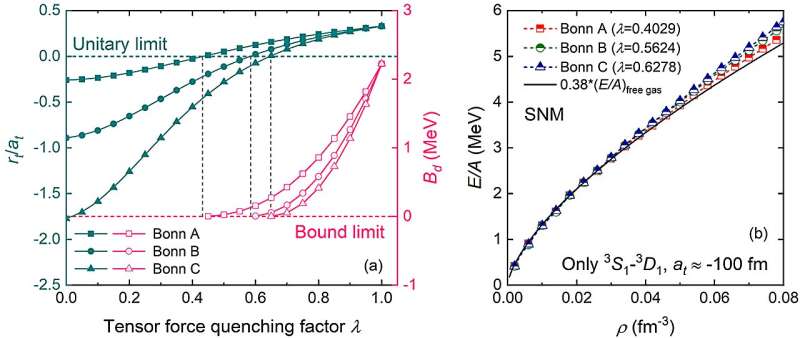This article has been reviewed according to Science X's editorial process and policies. Editors have highlighted the following attributes while ensuring the content's credibility:
fact-checked
trusted source
proofread
Tensor-force effects on nuclear matter in relativistic ab initio theory

Tensor force is a crucial ingredient of the nucleon-nucleon (NN) interaction, and has an important impact on the structural and dynamical properties of the nuclear many-body system. Many efforts have been devoted to studying the influence of the tensor force in the effective NN interaction in the nuclear medium. But less is known about the tensor-force effects from realistic NN interactions.
Starting from realistic NN interaction, the authors systematically study the tensor-force effects on the equation of state and symmetry energy of nuclear matter within the relativistic Brueckner-Hartree-Fock (RBHF) theory, which is one of the most important relativistic ab initio methods. For the binding energies per particle of symmetric nuclear matter (SNM) and the symmetry energy, the tensor-force effects are attractive and are more pronounced around the empirical saturation density. For pure neutron matter, the tensor- force effects are marginal.
This study also shows that the strong tensor force makes the neutron-proton system deviate from the unitary limit. By tuning the tensor-force strength, the dilute SNM is located at the unitary limit. With only the interaction in the 3S1–3D1 channel considered, the ground-state energy of dilute SNM is found proportional to that of a free Fermi gas with a scaling factor 0.38, which reveals good universal properties for four-component unitary Fermi gas (spin-1/2 and isospin-1/2).

This work paves the way to study the tensor-force effects in neutron stars as well as finite nuclei from realistic nucleon-nucleon interactions. This work also highlights the role of the tensor force in the deviation of nuclear physics to the unitary limit and provides a valuable reference for studies of the four-component unitary Fermi gas.
The work is published in the journal Science Bulletin.
This study was led by Prof. Jie Meng (State Key Laboratory of Nuclear Physics and Technology, School of Physics, Peking University). Numerical modeling and theoretical analyses were conducted mainly by Dr. Sibo Wang (Department of Physics and Chongqing Key Laboratory for Strongly Coupled Physics, Chongqing University).
More information: Sibo Wang et al, Tensor-force effects on nuclear matter in relativistic ab initio theory, Science Bulletin (2024). DOI: 10.1016/j.scib.2024.05.013
Provided by Science China Press





















